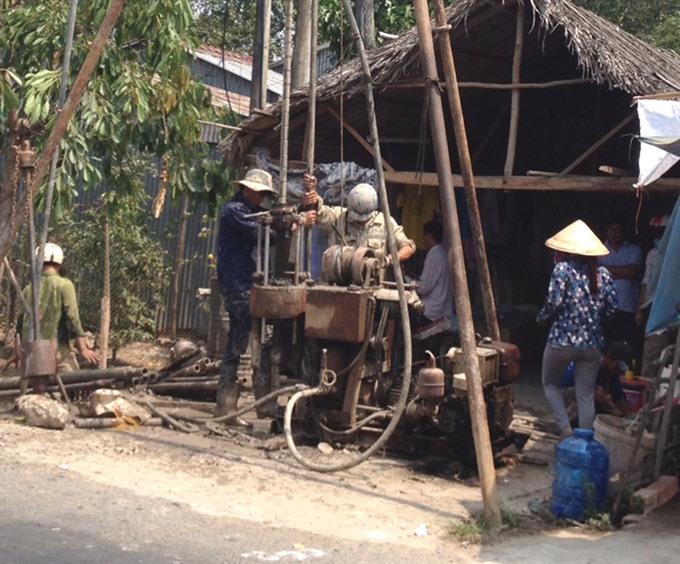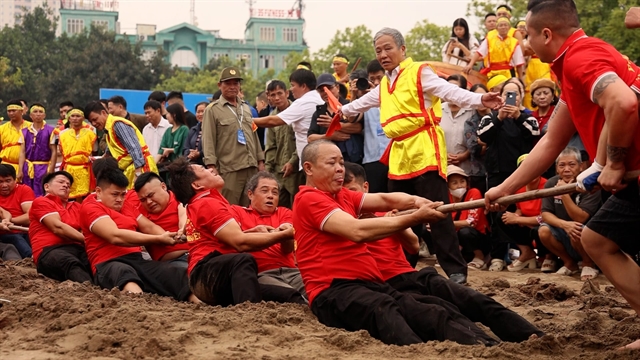 Society
Society

Up to four centimetres of land subsidence occurs in the Mekong Delta each year, and exploitation of groundwater is one of several factors causing it.
 |
| People drill wells in Lương Tâm Commune, Long Mỹ District in southern Long An Province for daily use and production, particularly during droughts. Underground water exploitation is blamed as main cause for land subsidence in the Mekong Delta region. — VNA/VNS Photo Huỳnh Sử |
HCM CITY — Up to four centimetres of land subsidence occurs in the Mekong Delta each year, and exploitation of groundwater is one of several factors causing it.
“The consequences of land sinking are much more serious than those of climate change and rising seas, especially in urban areas where people exploit groundwater,” Assoc Prof Dr Nguyễn Hiếu Trung of Cần Thơ University told a seminar held in Cần Thơ on Tuesday titled “Land subsidence in Mekong Delta: challenges and future solutions”.
Tom Kompier, first secretary, water resources and climate, at the Dutch embassy in Hà Nội, said the delta faces multiple challenges like the effects of climate change, rising sea levels, too many hydropower plants upstream and overexploitation of groundwater.
“Land subsidence will destroy infrastructure, increase the risk of flooding, cause loss of agricultural land, reduce production in flooded areas, cause landslides in coastal regions, change water flows in river systems and cause severe saline intrusion into both surface and groundwater.”
A study by Holland Utrecht University found groundwater in the Mekong Delta significantly decreasing because of overexploitation.
Trần Văn Thanh, deputy director of the Sóc Trăng Province Department of Natural Resources and Environment, said the province has six water-supply plants, all of which exploit ground water, especially in the dry season.
“Since 2013, due to severe droughts and saline intrusion, farmers in many districts have drilled and used groundwater for agriculture and aquaculture.”
Land subsidence is now accelerating in the delta, he said.
According to the Department of Transport of the southernmost province of Cà Mau, roads have sunk at 87 spots, damaging nearly 50km costing VNĐ110 billion (US$4.8 million).
Cà Mau has over 109,000 wells that supply a total of 373,000 cubic metres daily, and according to research by the Norwegian Geotechnical Institute, the entire province is sinking by 1.9 – 2.8cm each year.
The research also shows that between 1998 and 2013 land subsided by 30-80cm in Cà Mau, and it will accelerate to 90-150cm in the next 25 years and 210cm over the next 50 years.
In the last 20 years the sea has eroded 100m – 1.4km of coast in the province.
“To stop land from sinking, groundwater exploitation must be stopped and local authorities should supply water to aquifers, but this solution is for the very long term and expensive,” Prof Piet Hoekstra of Utrecht University said.
Before 1985 Japan had suffered from severe land subsidence because of oil and groundwater exploitation, Kỷ Quang Vinh, head of the Cần Thơ Climate Change Office, said.
The Japanese Government banned exploitation of groundwater, but by 2000 the groundwater had started recovering, he said.
“Cần Thơ has ordered a ban on groundwater exploitation, but we need a delta-wide ban for the region to recover its groundwater.”
The delta does not have large water bodies. Scientists have suggested that the region should recover former flooded areas that were dyked and encourage residents to build tanks and dig channels to store water for the dry season. — VNS




